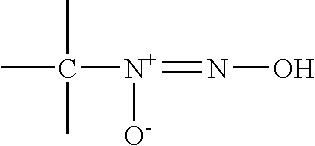Nitric oxide-releasing amidine- and enamine-derived diazeniumdiolates, compositions and uses thereof and method of making same
a technology of diazeniumdiolates and enamines, which is applied in the field of nitric oxide-releasing amidineand enamine-derived diazeniumdiolates, can solve the problems of carcinogenic nitrosamines, adducts of primary amines, and debate as to whether
- Summary
- Abstract
- Description
- Claims
- Application Information
AI Technical Summary
Problems solved by technology
Method used
Image
Examples
example 1
[0082]This example describes a generalized procedure for the preparation of NO- and / or NO−-releasing compounds from amidines.
[0083]A solution of the appropriate amidine, which was obtained commercially (Aldrich) or synthesized in accordance with standard procedures, in the desired solvent was placed in a standard Parr hydrogenation bottle. Nitrogen was passed through the apparatus and bubbled through the solution for 5-10 min, the bottle was clamped, and NO gas was admitted to a pressure of 5 atm. The solution was stirred for the indicated time at room temperature with addition of NO as needed during the first 5-6 h to maintain the reservoir pressure. Excess NO was then vented and N2 was bubbled through the resultant white slurry for 5 min. The product was isolated by filtration, washed with the reaction solvent, then washed with ether and dried in vacuo for several hours. All of the products were amorphous, voluminous white powders, which were air-stable but were stored in a refrig...
example 2
[0084]This example describes the preparation of 2-methyl-2-imidazoline tetrakis(nitric oxide)adduct and its sodium salt.
[0085]A solution of 2-methyl-2-imidazoline (lysidine, 5.0 g, 59.4 mmol) in 150 ml acetonitrile was reacted with NO for 28 h as described above. Yield 3.59 g (49%); m.p. 102-103° C. dec.; 1H NMR (D2O) δ 1.92 (6H, s), 3.51 (8H, s), 3.67 (4H, s); 13C NMR (D2O) 24.8, 42.4, 42.5, 44.6, 51.3, 51.7, 163.5, 177.2; UV (0.01 N NaOH) λmax 260 nm, =13,600 M−1cm−1, 206 nm, ε=22,500. Anal. Calcd for C12H24N10O4: C, 38.71; H, 6.50; N, 37.61. Found: C, 38.92; H, 6.55; N, 37.62.
[0086]To prepare the disodium salt, 1.74 g of a 25% NaOMe in MeOH solution (Aldrich, 8.06 mmol) was diluted with 0.5 ml MeOH and to this was added 1.5 g of the above diimidazolinium salt (8.06 mmol). The solid slowly dissolved and then re-precipitated. The slurry was diluted with acetonitrile, filtered and the solid dried in vacuo to afford a white powder. Yield 0.92 g (92%). m.p. >180° C. (chars); 1H NMR (D...
example 3
[0087]This example describes the preparation of acetamidine tetrakis (nitric oxide) adduct.
[0088]A solution of acetamidine hydrochloride (7.0 g, 74.0 mmol) in 150 ml acetonitrile was treated with 16.93 ml of 25% NaOMe in MeOH (74.0 mmol) and the precipitated sodium chloride was removed by filtration. The resulting solution was treated with NO for 16 h to yield a tan powder. Yield 5.95 g (82%); m.p. >150° C. (chars); 1H NMR (D2O) δ 2.21 (s); 13C NMR (D2O) 20.8, 51.8, 57.7, 164.6.
PUM
| Property | Measurement | Unit |
|---|---|---|
| pH | aaaaa | aaaaa |
| time | aaaaa | aaaaa |
| pressure | aaaaa | aaaaa |
Abstract
Description
Claims
Application Information
 Login to View More
Login to View More - R&D
- Intellectual Property
- Life Sciences
- Materials
- Tech Scout
- Unparalleled Data Quality
- Higher Quality Content
- 60% Fewer Hallucinations
Browse by: Latest US Patents, China's latest patents, Technical Efficacy Thesaurus, Application Domain, Technology Topic, Popular Technical Reports.
© 2025 PatSnap. All rights reserved.Legal|Privacy policy|Modern Slavery Act Transparency Statement|Sitemap|About US| Contact US: help@patsnap.com



